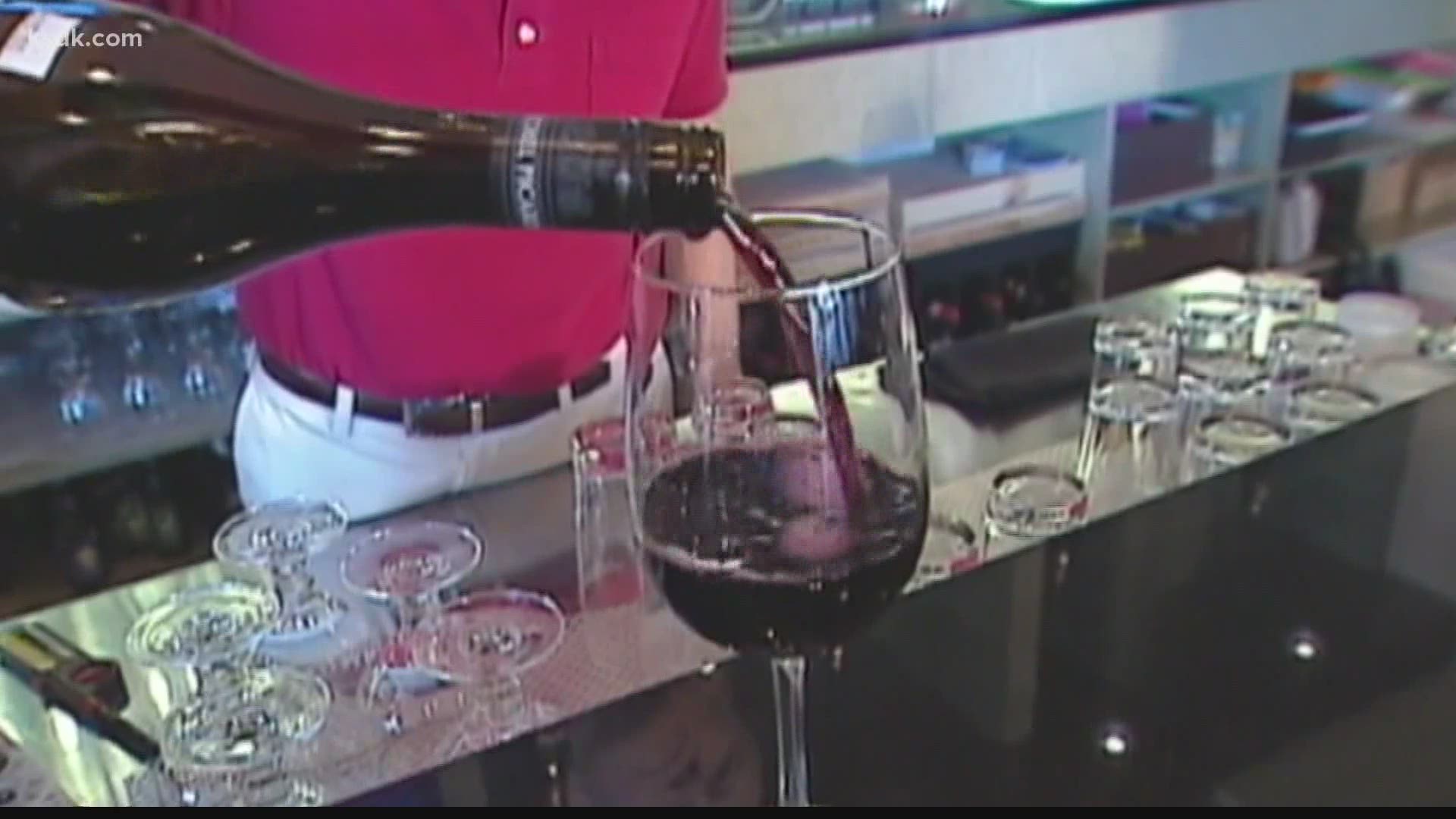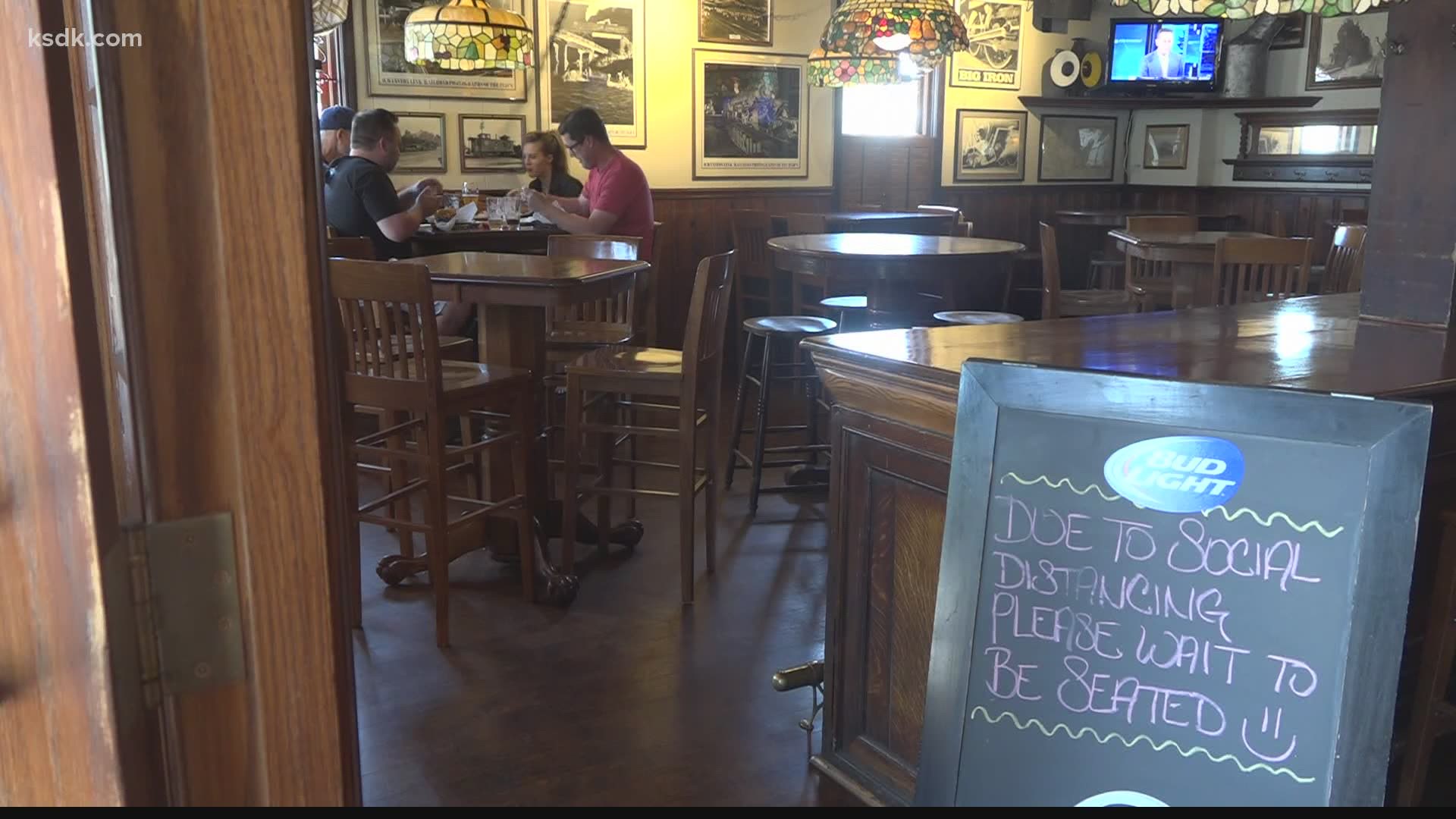ST. LOUIS COUNTY, Mo. — Bars in St. Louis County will be able to reopen soon.
Restaurants in the area began to reopen on May 18.
St. Louis County Executive Sam Page said establishments that sell primarily alcohol, may reopen at 25% restricted capacity.
The guidelines ask for establishments to install a Plexiglas barrier if customers will directly be ordering from a bartender - table service is recommended.
St. Louis County wrote on its website that the goal of the protocols outlined is to reduce the risk of spreading the virus among staff and guests.
The core set of principles to prevent the spread of infections by respiratory transmission (including COVID-19) include:
- Practice social distancing – maintain 6 feet between and among employees and guests at all times.
- Monitor employee health – check the status of your employee’s health and screen employees for COVID-19.
- Use protective equipment – a fabric face cover must always be worn by employees and guests, except when eating.
- Clean/sanitize/disinfect – wash and sanitize hands, and wipe down frequently touched surfaces with EPA-approved disinfectant.
- If the building has been closed for an extended period of time, ensure that water and HVAC systems are operating safely. Dangerous mold can develop in unoccupied buildings and stagnant water pipes pose a risk for Legionnaire’s disease. Refer to CDC guidance
- Arrange the dining room or bar area to ensure that there is always 6 feet of distance between patrons at different tables or at the bar. Consider leaving empty tables (clearly marked as such) between each occupied table.
- In restaurants or bars with booth seating that cannot be rearranged to provide distance, install barriers that rise at least 60 inches from the floor using plexiglas or other solid material. Barriers should also be installed at cash registers, host stands, and anywhere 6 feet of distance cannot be maintained.
- Outdoor dining or outdoor bar areas are recommended as it allows for greater ventilation and may reduce transmission. County officials will assist you in obtaining the necessary permits to introduce or expand your outside dining or bar space. The Food Safety Program can be reached at 314-615-8900. Separation regulations apply equally to interior and exterior dining.
- Food prep stations in the kitchen must be set up at least 6 feet apart. Kitchen staff should practice ‘no-contact’ transfers: place items down on a counter for the next person to pick up, rather than handing them off directly.
- If the building has been closed for an extended period of time, check date-marked foods and discard all that have gone beyond their expiration
- Food and drink preparation must be completed inside the permitted food facility and cannot be moved outdoors
- Capacity of the combined outdoor and indoor spaces cannot exceed the total previously approved capacity for the establishment
- Establishments that primarily serve alcohol but do not serve full meals may reopen June 8 at 25% capacity based on the facility’s authorized fire and building code occupancy. Bars should abide by all general restaurant guidelines outlined as well.
- Customers may not sit at the bar or any other location within 6 feet of areas where drinks are prepared. Service items like napkins, garnishes, straws, etc. should be kept behind the bar and away from areas where customers might order or pick up drinks.
- Table service is recommended. If customers will be ordering directly from the bartender, install a Plexiglas barrier at the ordering point. Mark off areas on the floor to ensure that customers are properly spaced while ordering.
- Customers must remain seated while consuming drinks. Space out tables and limit group size in the same manner recommended for dine-in restaurant service. Do not allow groups to congregate while standing or dancing.
- Customers may not use pool tables, dart boards, arcade games, or any other shared recreational equipment or any other shared recreational equipment that may be available.
- Train staff to handle customer interactions and remove any customer who cannot obey public health guidelines.
- Use EPA-approved disinfectants for all routine cleaning. Diluted bleach solutions (1/3 cup bleach per gallon of water) may be used for appropriate surfaces. For a list of products that meet the EPA’s criteria for use against the novel coronavirus
- Make disinfectant wipes available to front-of-house staff and instruct them to wipe down countertops, tables, chairs, pens and other shared surfaces.
- Kitchen surfaces, especially hand sinks, handles, prep stations, and door knobs need to be wiped down with disinfectant or EPA approved sanitizer at least every hour. A log should be created to document all practices with a two-person verification checklist.
- Place hand sanitizer near entrances and exits and payment stations.
- Ensure that all shared surfaced and objects are wiped down with disinfectant between each customer, including tables, chairs, receipt trays, menus, condiment bottles, and anything that could have been touched by prior customers.
- China, glass and silverware may be used for in-restaurant dining as long as FDA-approved washing, rinsing and sanitizing standards are met. Diligent care should be taken to ensure sanitizer concentration and water temperature requirements are strictly followed and dish washing machine mechanisms are working properly. (Disposable products preferred)
- Give additional training to all cleaning staff. Staff should know how to put on and remove disposable gloves safely, use disinfectants according to manufacturer directions, and disinfect all high-touch surfaces.
- Provide all staff members with proper protective equipment, including fabric or disposable face coverings. Instruct staff on the proper use of PPE to avoid cross-contamination.
- All restaurant kitchen staff must wear the following protective equipment while on site:
- Disposable food-grade gloves
- Hairnet, hat, or other hair restraints
- Face covering (fabric or disposable masks)
- Service staff must wear a fabric or disposable face covering at all times; guest must wear them unless seated at their tables. Servers are not required to wear gloves, but must wash their hands frequently and between serving tables.
- Staff should change their face coverings if they become soiled, torn or wet. Change gloves when switching tasks, handling different foods, or after touching objects that should be considered contaminated (cell phone, computer, clothes, door handles, etc.), or if a glove is torn or punctured. Wash/sanitize hands after changing masks and before putting on a new pair of gloves.
- Designate trash cans with closed lids specifically for disposal of worn PPE. Empty these trash cans frequently, always wearing gloves that are then disposed of after removal.
- Upon arrival at work, employees must be masked, and employers must conduct health checks. Conduct health checks safely and respectfully, and in accordance with any applicable privacy laws.
- Screening should include a temperature check using a touchless thermometer, questions about the presence of cough, shortness of breath or trouble breathing, fever, chills, muscle aches, sore throat, or loss of taste or smell and questions about close contact with any person diagnosed with COVID-19 in the past 14 days.
- Employees with a temperature of 100.4°F or above, or who answer yes to any of the screening questions, must not be allowed to enter the workplace.
- If an employee is diagnosed with COVID-19, work with local health agencies to ensure all employees and customers who can be identified as having had contact while the employee was infectious are contacted. Compile a list of employees, customers, or others known to be in close contact with the person.
- Employees should be made aware of the provisions of the federal Families First Coronavirus Response Act, which allows for paid sick leave or expanded family and medical leave for specified reasons, such as for self-quarantining or seeking a medical diagnosis for COVID-19 symptoms.
- Keep all personal items, including cell phones and outerwear, in designated areas to prevent contamination of workspaces. Reusable bottles/cups must stay in this personal items area.
- Train all staff to recognize the signs and symptoms of COVID-19.
- Establishments must operate at 25% capacity based on the facility’s authorized fire and building code occupancy. Consider assigning a staff member to work the door and monitor the number of customers entering and leaving.
- Post both interior and exterior signs reminding customers not to enter the restaurant if they have symptoms and to obey social distancing requirements.
- Patrons who are waiting to be seated may not congregate on the premises. Consider establishing a reservation-only or call-ahead seating policy to prevent crowding. Do not use shared buzzers to notify waiting patrons of open tables.
- Group sizes larger than 10 are not permitted. It is recommended that no more than 6 people be seated at a table.
- Establish record-keeping systems to assist public health officials with contact tracing if necessary. Your POS system may provide this function or you may wish to use of a hand registry to record reservations and phone numbers.
- Encourage high-risk individuals to order take-out or delivery or offer special time periods, such as senior citizen hours, where there are even fewer people in the establishment.
- If lines are likely to form at pay stations, use tape to mark off six-foot spaces. You may wish to consider using portable or iPad payment systems that allow servers to process transactions tableside.
- No self-serve drink, food service, or buffet options are allowed unless the food or drink is pre-packaged.
- Make sure that there are clear pathways, establishing one-way pathways when possible, throughout the establishment, including to and from entrances, restrooms, and payment stations.
- Prop open frequently used interior doors to limit contact with doorknobs. Increase ventilation by opening exterior doors and windows if this can be done while maintaining other health and safety practices.
- Cups, lids, napkins, and straws should be brought directly to customers by staff and not placed out for self-service. Do not place utensils on table until patrons are seated.
- Keep condiments, including salt and pepper shakers, off of tables and have servers bring them when requested, or consider using single-serve condiment packages. Clean shakers after each party’s use and discard any remaining single serve packages.
- Encourage guests to pay and tip with credit or debit cards and to use their own pens to sign receipts. Employees must wash their hands after handling cash.
- Practice contactless transfers by placing items down on a counter for the customer to pick up. In the case of curbside delivery, ask the guest to open their trunk and have employees place the order in the trunk.



